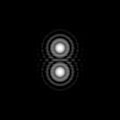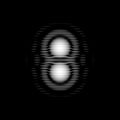User:Timm Weitkamp
Jump to navigation
Jump to search
| Babel user information | ||
|---|---|---|
| ||
| Users by language |
Terms of use for my media
[edit]The material I make available through Wikimedia Commons is licensed under the Creative Commons Attribution 3.0 Germany license. Here's a very brief summary of some of the the license terms:
- You may copy, distribute and transmit the work (even commercially), and adapt (i.e., modify) it.
- But, when doing any of this, you must attribute this work to me, i.e., mention that this is my work (see below for how to do it), and mention the license terms of this work (for example with a link to the license web page). That means: every time you present or re-distribute my material or derivatives of it, you should acknowledge me as the author of the original material. This acknowledgment, or "author attribution" in the terms of the Creative Commons license, is important for me, so I kindly ask you to respect these guidelines.
- What text should the author attribution contain?
- The acknowledgment should contain my name. As a minimum wording, you could use "Image: T. Weitkamp."
- If you use an image in a presentation or article aimed at a scientific audience, and if the description of that image contains a reference to a scientific article, then the acknowledgment should also contain a reference to the article.
- Where should the author attribution be placed?
- When you use an image on a web page, the acknowledgement should be placed next to the image (or be part of the image) and clearly visible.
- When you use images in a figure for an article or in a book, the acknowledgment should be contained in the figure caption.
- When you use images in a presentation, the acknowledgment should be on the same slide as the image(s), as close as possible to the image.
- If in doubt, contact me and ask.
- What text should the author attribution contain?
Thank you, and have fun!
Contact
[edit]The best way to contact me for Wikimedia Commons-related matters is through User talk:Timm Weitkamp. Alternatively, visit my laboratory web page for contact details.
Galleries
[edit]The images below were made with the XWFP propagation code (T. Weitkamp, Proceedings SPIE 5536 (2004) 181-189, doi:10.1117/12.569642), using a Fresnel propagation kernel in paraxial approximation.
Simulated X-ray phase contrast radiographs
[edit]- From near field to far field
-
Fig. 1: Phantom object for X-ray phase contrast simulations. Red: fully absorbing disks. Blue: phase-shifting disks with zero absorption. Disk diameter: 5 µm. The whole image corresponds to an area of 50×50 µm2.
-
Fig. 2a: Simulated radiograph for illumination of the phantom from Fig. 1 with a plane monochromatic coherent wave of 12.4 keV photon energy, for a detector placed at a distance D=0.1 mm behind the object.
-
Fig. 2b: Same as Fig. 2a, but for D=1 mm.
-
Fig. 2c: Same as Fig. 2a, but for D=10 mm.
-
Fig. 2d: Same as Fig. 2a, but for D=100 mm.
-
Fig. 2e: Same as Fig. 2a, but for D=1000 mm.
-
Fig. 2f: Presentation slide.
X-ray double slit experiment simulations
[edit]- Transverse-longitudinal intensity distributions for different energies
-
Simulated intensity distribution after a double slit (slit spacing 10 µm, slit width 2.5 µm) illuminated by a monochromatic plane X-ray wave of photon energy E=5 keV. [more...]
-
Same, for E=7.5 keV.
-
Same, for E=10 keV.
-
Same, for E=12.5 keV.
-
Same, for E=15 keV.
-
For 5 keV, but larger: 2000x1500 pixels.
-
For 5 keV, but larger (2000x1500 pixels) and using a blue-white color map.
-
False-color representation of a polychromatic case.
- Transverse-transverse intensity distributions for different distances
-
Simulated intensity distribution after a double pinhole (pinhole spacing 10 µm, pinhole diameter 2.5 µm) illuminated by a monochromatic plane X-ray wave of 0.1 nm wavelength. [more...]
-
Same, but for z=20 mm.
-
Same, but for z=50 mm.
-
Same, but for z=100 mm.
-
Same, but for z=200 mm.
-
Same, but for z=400 mm.
-
Same, but for z=600 mm.


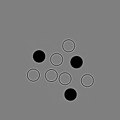
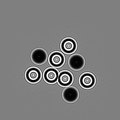

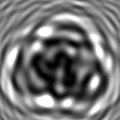

![Simulated intensity distribution after a double slit (slit spacing 10 µm, slit width 2.5 µm) illuminated by a monochromatic plane X-ray wave of photon energy E=5 keV. [more...]](https://upload.wikimedia.org/wikipedia/commons/thumb/b/b6/Double_slit_x-ray_simulation_trans-long_05000_eV.jpg/120px-Double_slit_x-ray_simulation_trans-long_05000_eV.jpg)







![Simulated intensity distribution after a double pinhole (pinhole spacing 10 µm, pinhole diameter 2.5 µm) illuminated by a monochromatic plane X-ray wave of 0.1 nm wavelength. [more...]](https://upload.wikimedia.org/wikipedia/commons/thumb/6/60/Double_slit_x-ray_simulation_0000mm_log-grayscale.jpg/120px-Double_slit_x-ray_simulation_0000mm_log-grayscale.jpg)

